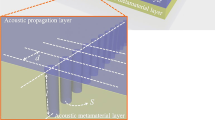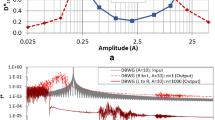Abstract
This work is a study of acoustic non-reciprocity exhibited by a passive (i.e., with no active or semi-active feedback) one-dimensional (1D) linear waveguide incorporating two local strongly nonlinear, asymmetric gates. Strong coupling between the constituent oscillators of the linear waveguide is assumed, resulting in broadband capacity for wave transmission in its passband. Two local nonlinear gates break the symmetry and linearity of the waveguide, yielding strong global non-reciprocal acoustics, in the way that extremely different acoustical responses occur depending on the side of application of harmonic excitation, that is, for left-to-right (L–R) or right-to-left (R–L) wave propagation. To the authors’ best knowledge that the present two-gated waveguide is capable of extremely high acoustic non-reciprocity, at a much higher level to what is reported by active or passive devices in the current literature; moreover, this extreme performance combines with acceptable levels of transmissibility in the desired (preferred) direction of wave propagation. Machine learning is utilized for predictive design of this gated waveguide in terms of the measures of transmissibility and non-reciprocity, with the aim of reducing the required computational time for high-dimensional parameter space analysis. The study sheds new light into the physics of these media and considers the advantages and limitations of using neural networks to analyze this type of physical problems. In the predicted desirable parameter space for intense non-reciprocity, the maximum transmissibility reaches as much as 40%, and the transmitted energy from upstream (i.e., the part of the waveguide where the excitation is applied) to downstream (i.e., in the part of the waveguide after the two nonlinear gates) varies by up to nine orders of magnitude, depending on the direction of wave transmission. The machine learning tools along with the numerical methods of this work can inform predictive designs of practical non-reciprocal waveguides and acoustic metamaterials that incorporate local nonlinear gates. The current paper shows that combinations of nonlinear gates can lead to extremely high non-reciprocity while maintaining desired levels of transmissibility. This could lead to future investigation of how multiple nonlinear gates can be used as building blocks of designs incorporating robust passive acoustic non-reciprocity.













Similar content being viewed by others
Data availability
Enquiries about data availability should be directed to the authors.
References
Achenbach, J.: Reciprocity in Elastodynamics. Cambridge University Press, Cambridge (2009)
Maxwell, J.C.: On the calculation of the equilibrium and stiffness of frames. Lond. Edinb. Dublin Philos. Mag. J. Sci. 27, 294–299 (1864)
Tsakmakidis, K., Shen, L., Schulz, S., Zheng, X., Upham, J., Deng, X., Altug, H., Vakakis, A.F., Boyd, R.W.: Breaking Lorentz reciprocity to overcome the time-bandwidth limit in physics and engineering. Science 356(6344), 1260–1264 (2017)
Fleury, R., Sounas, D., Sieck, C., Haberman, M., Alù, A.: Sound isolation and giant linear nonreciprocity in a compact acoustic circulator. Science 343(6170), 516–519 (2014)
Cummer, S.A.: Selecting the direction of sound transmission. Science 343(6170), 495–496 (2014)
Cummer, S.A., Christensen, J., Alù, A.: Controlling sound with acoustic metamaterials. Nat. Rev. Mater. 1(3), 1–13 (2016)
Grinberg, I., Vakakis, A.F., Gendelman, O.V.: Acoustic diode: wave non-reciprocity in nonlinearly coupled waveguides. Wave Motion 83, 49–66 (2018)
Darabi, A., Fang, L., Mojahed, A., Fronk, M.D., Vakakis, A.F., Leamy, M.J.: Broadband passive nonlinear acoustic diode. Phys. Rev. B 99(21), 214305 (2019)
Trainiti, G., Ruzzene, M.: Non-reciprocal elastic wave propagation in spatiotemporal periodic structures. New J. Phys. 18(8), 083047 (2016)
Maznev, A.A., Every, A.G., Wright, O.B.: Reciprocity in reflection and transmission: what is a ‘phonon diode’? Wave Motion 50(4), 776–784 (2013)
Liang, B., Guo, X.S., Tu, J., Zhang, D., Cheng, J.C.: An acoustic rectifier. Nat. Mater. 9(12), 989–992 (2010)
Fu, C., Wang, B., Zhao, T., Chen, C.Q.: High efficiency and broadband acoustic diodes. Appl. Phys. Lett. 112(5), 051902 (2018)
Mousavi, S.H., Khanikaev, A.B., Wang, Z.: Topologically protected elastic waves in phononic metamaterials. Nat. Commun. 6(1), 1–7 (2015)
Wang, C., Kanj, A., Mojahed, A., Tawfick, S., Vakakis, A.F.: Experimental Landau-Zener tunneling (LZT) for wave redirection in nonlinear waveguides. Phys. Rev. Appl. 14(3), 034053 (2020)
Wang, C., Mojahed, A., Tawfick, S., Vakakis, A.F.: Machine learning non-reciprocity of a linear waveguide with a local nonlinear, asymmetric case: weak coupling. J. Sound Vib. 537, 117211 (2022)
Blanchard, A., Sapsis, T.P., Vakakis, A.F.: Non-reciprocity in nonlinear elastodynamics. J. Sound Vib. 412, 326–335 (2018)
Wang, C., Mojahed, A., Tawfick, S., Vakakis, A.F.: Machine learning non-reciprocity of a linear waveguide with a local nonlinear, asymmetric gate: case of strong coupling. J. Comput. Nonlinear Dyn. 18, 031004 (2013)
Zhai, Y., Kwon, H., Popa, B.: Active Willis metamaterials for ultracompact nonreciprocal linear acoustic devices. Phys. Rev. B 99, 220301 (2019)
Popa, B., Cummer, S.A.: Non-reciprocal and highly nonlinear active acoustic metamaterials. Nat. Commun. 5, 3398 (2014)
Geib, N., Sasmal, A., Wang, Z., Zhai, Y., Popa, B., Grosh, K.: Tunable nonlocal purely active nonreciprocal acoustic media. Phys. Rev. B 103, 165427 (2021)
Funding
The authors have not disclosed any funding.
Author information
Authors and Affiliations
Corresponding author
Ethics declarations
Conflict of interest
The authors have not disclosed any competing interests.
Additional information
Publisher's Note
Springer Nature remains neutral with regard to jurisdictional claims in published maps and institutional affiliations.
Rights and permissions
Springer Nature or its licensor (e.g. a society or other partner) holds exclusive rights to this article under a publishing agreement with the author(s) or other rightsholder(s); author self-archiving of the accepted manuscript version of this article is solely governed by the terms of such publishing agreement and applicable law.
About this article
Cite this article
Michaloliakos, A., Wang, C. & Vakakis, A.F. Machine learning extreme acoustic non-reciprocity in a linear waveguide with multiple nonlinear asymmetric gates. Nonlinear Dyn 111, 17277–17297 (2023). https://doi.org/10.1007/s11071-023-08765-4
Received:
Accepted:
Published:
Issue Date:
DOI: https://doi.org/10.1007/s11071-023-08765-4




